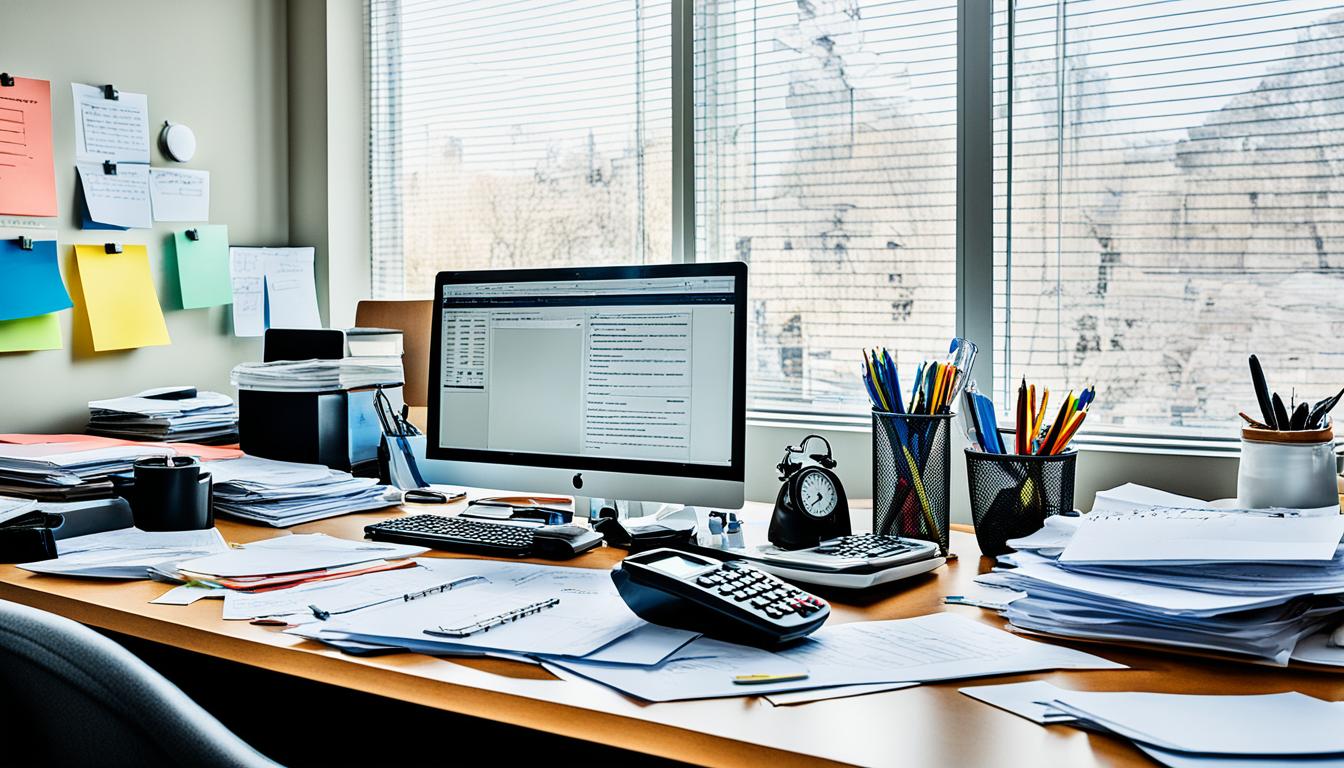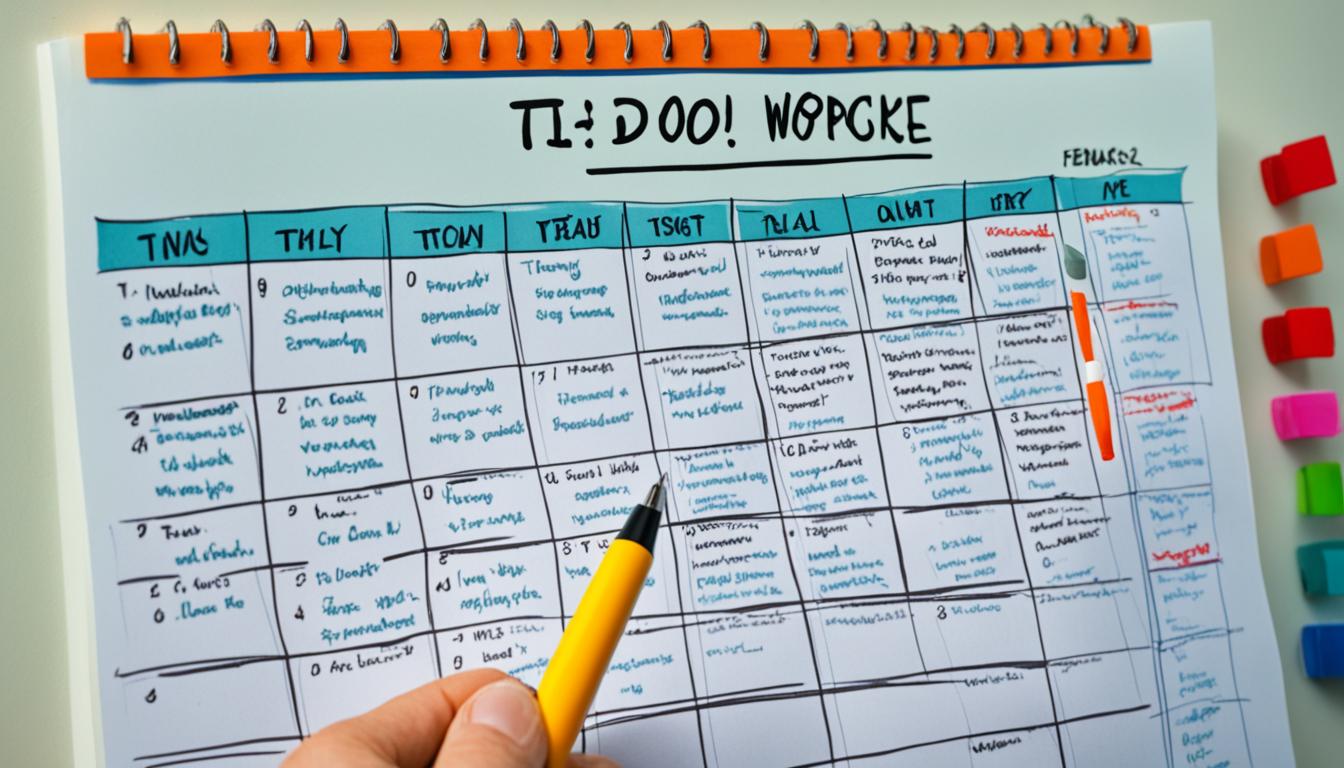Interruptions at work can really lower your productivity and make stress go up. These disruptions also come with hidden costs, such as reduced work quality, increased employee stress, and a negative impact on overall well-being and business performance. At the office, disruptions can waste up to 30 minutes as you try to get back on track. Even in places where people are really focused, there’s usually at least one interruption every day. This can make you feel less productive, even when you’re making progress. Research and insights from the Harvard Business Review highlight how interruptions not only decrease productivity but also create attention residue, making it harder to regain focus after each disruption.
It’s key to set limits on distractions at work to stay focused and work better. Keeping an Interrupters Log, having planned meetings for smaller issues, and making clear to-do lists can help. Dealing with interruptions calmly and feeling good about what you accomplish can also keep you motivated and focused.
This article will show you how to keep interruptions at bay, whether you’re at home or in the office. Keep reading for tips and tricks to stay focused and work more efficiently.

By using these strategies, you can cut down on interruptions. This will make your work environment more productive and improve your overall performance at work.
Understanding the Types of Interruptions at Work
There are two main types of work interruptions: valid and invalid. Knowing the difference helps keep productivity high. It also improves workplace communication. Office interruptions, such as emails, calls, and coworker visits, are a frequent challenge in the modern workplace and can significantly impact concentration and mental focus.
Invalid interruptions often include unnecessary interruptions, which are a common source of lost productivity. Minimizing these unnecessary interruptions can help improve focus and overall efficiency.
Valid Interruptions
Valid interruptions are important for your job. They need quick responses. They include intern questions, team updates, or family emergencies. Handling these quickly keeps work flowing smoothly. It also helps team communication. Even though interruptions happen, many people work faster afterwards. This can save time but also cause stress.

Invalid Interruptions
Invalid interruptions are not about work and should wait. They include personal calls and social media alerts. These distractions can make it hard to stay focused. Frequent interruptions, in particular, make it especially difficult to maintain focus and can significantly reduce productivity over time. After being interrupted, it can take 23 minutes to focus again. This lost time can add up.
Knowing how to manage interruptions is key. It helps tell work-related distractions from others. Good management keeps the work environment productive.
Strategies to Minimize Interractions at Work
Handling interruptions at work is key to staying productive. Using some strategies can help you focus better and reduce distractions. Identifying and implementing ways to minimize interruptions and manage distractions is essential for improving productivity and maintaining focus. We’ll show you how to keep interruptions low so you can focus more during your workday.
Log Your Interruptions
Keeping a record of interruptions helps you understand and lessen them. By noting when disruptions happen, you can see patterns and fix them. This helps you solve repeat problems, train colleagues, and create helpful guides for everyone to use.
Use Routine Meetings
Setting meetings regularly can cut down on sudden interruptions. Having fixed times for updates means important stuff gets shared without disrupting work. Also, using good communication inside the team can prevent interruptions that happen when people don’t have the info they need.
Budget Time for Interruptions
Planning time for interruptions in your schedule is a smart move. Having specific times to deal with disruptions helps keep your main work time focused. Good planning, like making yearly and every-three-month plans, reduces surprises and keeps interruptions fewer. It’s also important to allow for recovery time after each interruption, as this period helps you regain focus and maintain productivity.

Utilize Technology to Reduce Distractions
Technology tools in the workplace help manage interruptions. Using Do Not Disturb features helps lower digital distractions. Knowledge workers face around 14 interruptions daily due to emails and messages. Incoming communications—such as emails, texts, and notifications—are a major source of digital interruptions, so managing these efficiently is key to maintaining focus.
Do Not Disturb Functions
The Do Not Disturb feature blocks notifications for a time. It’s great for those easily distracted. It can be used for important tasks to ensure focused work time, including blocking phone calls that might otherwise interrupt your concentration.
Workers spend over three hours daily on emails. They check these tools every six minutes. The Do Not Disturb feature is crucial for staying focused.
Status Settings on Communication Tools
Status options on tools like Slack or Microsoft Teams are key. They show when someone is busy, reducing interruptions. People get distracted every few minutes.
Using these settings tells others when to reach out. This results in more focused work periods.
Setting Boundaries with Colleagues and Family
Setting clear workplace boundaries is needed to manage interruptions. Since February 2020, meetings have increased by 69.7%. It’s important to tell colleagues how you prefer to communicate. This includes how soon you’ll reply to them. Also, keep meetings as short as planned to avoid running late.
To handle coworkers well, make emotional boundaries at work. This keeps you well and makes work better for everyone. Co-workers stopping by your desk to chit-chat is a common source of interruptions—consider using visual signals at your desk, like headphones or a sign, to let others know when you need focused work time. Set aside specific times for focused work. Also, make your working hours clear on your calendar. For family, stop burnout by having office hours and your own workspace.

Employees work about 47.6 hours each week, often more than normal hours. Having your own work area and protecting your own time is vital for maintaining productivity and well-being. This is because over 40% feel burned out from too much work. Saying no to too much work helps keep a good work-life balance.
When you set boundaries at work, it makes work relationships better. Supportive co-worker communication helps manage interruptions and creates a more positive work environment. Since we spend a lot of our lives at work, these boundaries make work happier and more productive. For women balancing career and family, this is even more important. Both men and women do better with clear work boundaries and less contact with difficult coworkers.
Managing Interruptions When Working from Home
Setting boundaries for remote work is key to staying productive. Effective strategies and a good home office setup are important. Interrupts at home are different than at the office. They often include pets, family, and unexpected visitors, who can be a common source of distraction in remote work environments. A plan to handle these can help you stay focused.
When it comes to family and pets, a person interrupting your work can disrupt your focus and reduce productivity, making it important to address these interruptions directly.
Planning ahead is crucial. Make sure to communicate boundaries clearly with each person in your household to minimize interruptions and maintain your workflow.
Dedicated Workspace
Having a specific place to work at home is essential. This area should be only for work. It tells your family you need to focus. Keeping work space away from where you relax is important. Close the door to keep out pets. Signs and noise-canceling headphones also help with focus. Wearing headphones can be an effective way to signal to others that you do not want to be disturbed.

Office Hours and Communication
Setting clear work hours is crucial. It tells others when you’re busy or free. Try to work when it’s quiet, like during children’s naps. Turning off your phone can also help. Good communication with those you live with is vital. Let them know your schedule. This helps avoid disruptions and keeps things running smoothly.
How to Refocus After an Interruption
In today’s world, we often face interruptions at work. Meetings, text messages, and chats quickly pull us away from our tasks. These breaks can hurt our work, especially because of attention residue—when part of your focus remains stuck on the previous task, making it harder to fully concentrate after an interruption. But, it’s possible to get back on track quickly and keep our productivity up. Studies show that 40% of workers get interrupted over 10 times a day. And 15% see more than 20 interruptions. Here’s how to bounce back from distractions, manage task switching, and re-immerse yourself in your work to focus again.

Note Your Last Train of Thought
Writing down your thoughts before a distraction can help a lot. This trick makes it easier to focus again. It also cuts down the time to get back into full work mode. By knowing where you stopped, getting back to work feels easier.
Re-read Your Work
Going over what you’ve already done also helps to refocus. It connects you back with your task. By doing this, your work after an interruption gets better and more focused.
Take Short Breaks
Taking small breaks can really help your brain. A quick pause helps you recover from the busy moments. When you return, you’ll find focusing easier and do better work.
While interruptions are part of the job, you can lessen their effects. Creating a “Ready-to-Resume” plan is smart. It helps decrease leftover distractions and makes focusing again easier.
Effective Time Management Techniques
Learning how to manage your time well is key at work. To maximize productivity, it’s important to schedule dedicated ‘focus time’ and ensure your tasks are aligned with your top ‘priorities.’ You should make a daily plan and stick to it. Also, set times for checking emails and focus on big tasks first. Setting aside periods for ‘deep work’ allows you to accomplish high-value tasks without interruptions. This will help you do more each day. It also means you can reach your goals more often.

Create a Daily Plan
Making a daily schedule is a great start. Do one thing at a time and plan it out. Focusing on one task at a time, instead of multitasking, can reduce stress and improve productivity by minimizing the negative effects of constant task switching. Know when you work best and do important tasks then. For help, look at these tips from time management experts. They suggest using planners or apps to keep track.
Schedule Email Sessions
Emails can take up a lot of time if not managed right. Check them only a few times each day. Experts say four times should be enough. Turn off notifications to keep focused. Use schedules and systems to organize. To learn more, visit how to manage interruptions.
Prioritize Important Tasks
Choosing what task to do first is very important. Break big tasks into smaller ones to finish them easier. Not all tasks require the same level of attention, so match your focus to the complexity of each task. This way, the most urgent tasks get done first. Setting time for these tasks helps a lot. It makes you and your team more productive. Check out these techniques for more ideas.
Avoiding Self-Imposed Distractions
Reducing self-made distractions can help improve focus and getting more work done. Practicing self control is essential for resisting self-imposed distractions and maintaining concentration throughout the workday. By learning about common workplace disruptions, workers can actively prevent them. Gaining a better understanding of your own productivity patterns can help you optimize your work habits and minimize interruptions. Every hour, people face about 15 distractions, or one every four minutes.
Moreover, 40% of workers can’t stay focused for 30 straight minutes in a day. One can lessen self-distractions by planning break times and doing a distraction detox.
Set Break Times
Setting up structured break times can cut down on distractions and promote productivity. Taking breaks regularly is key to avoiding burnout and keeping productivity high. Every day, people run into 50 to 60 disturbances, but 80% are not important.
By planning breaks, you can manage your day better and stop unexpected interruptions. Sticking to these break times helps focus better during work sessions.

Distraction Detox
Doing a “distraction detox” can effectively reduce self-distractions. Cutting down on social media and unrelated web browsing helps stay on track. Social media alone makes the US lose about $650 billion every year in productivity.
By turning off notifications and blocking distracting sites, you can keep a productive mindset. This approach helps in maintaining focus, especially since 40% of folks struggle to get back to work after a pause.
Handling Constant Interruptions at Work
Many people deal with constant work interruptions. These interruptions can hinder productivity and increase the cost to both employees and organizations, as time and resources are lost to frequent distractions. Learning to handle these can help you stay focused and productive.
Identifying Persistent Interruptions
Studies show that workers get interrupted every 6 to 12 minutes. Before Covid-19, a survey found that 40% had over 10 daily interruptions. 15% even faced more than 20. Tracking these can show patterns and help find solutions.
People usually spend about 12 minutes on a task before a distraction. It then takes about 25 minutes to get back on track. This shows distractions waste a lot of time and hurt productivity.
Communicating Boundaries
It’s vital to set clear work boundaries. Tell your coworkers and family when and how to contact you. This reduces distractions. Open-plan offices see 63% of tasks get interrupted, versus 49% in private offices.
Try scheduling times for updates and focus periods. Make it a priority to protect your focused work time from unnecessary interruptions. Keeping to these boundaries helps everyone. It leads to better focus and higher work quality.
Conclusion
Understanding the different types of workday disruptions is key. In the modern workplace, managing interruptions is especially important due to frequent digital distractions and evolving work settings. Using strategies like logging interruptions helps a lot. Also, meetings for unexpected demands and time set aside for disruptions are vital.
Using Do Not Disturb on tech keeps distractions away. This helps everyone stay focused at work.
It’s important to set boundaries at work, especially when working from home. Having your own work area, sticking to a schedule, and good communication help. After getting sidetracked, write down thoughts, read what you wrote before, and take breaks to refocus.
Planning your day helps keep focus. Set times for emails and focus on important tasks. Avoid distractions by planning breaks and detoxing from distractions. Protecting your cognitive resources and focus during complex tasks is crucial for maintaining high employee satisfaction. These steps help keep work flowing without interruptions.
FAQ
What are the different types of workplace interruptions?
In the workplace, you can have valid or invalid distractions. Valid ones are about your job or urgent family needs. Things like team news or urgent issues at home. Invalid ones are not about work. They include personal calls or social media that’s not work-related.
How can I minimize workplace distractions?
To cut down distractions, keep an Interrupters Log. Plan for distractions this way. Have routine meetings for chats that aren’t urgent. Set times for dealing with interruptions. Use your calendar to show when you’re free. This helps manage surprise disruptions.
What technology can help reduce digital distractions?
Use ‘Do Not Disturb’ on phones and status settings on communications like Slack. These show you’re busy. Regular use helps you focus by cutting down digital interruptions.
How do I set boundaries with colleagues and family to prevent interruptions?
Talk openly about your work and what you need to get done. Saying “no” is okay to avoid too much work. At home, set ‘office hours’ and have a special work area. This is very important.
What strategies can help manage interruptions when working from home?
At home, make a spot that’s for work only. No one should bother you there. Have ‘office hours’ so everyone knows when you need quiet. Talking about your schedule with your family or roommates helps a lot.
How can I refocus after an interruption?
To get back on track, write down your last idea. Then you can start quickly. Look at what you were doing before to get back into it. Take short breaks to clear your head. This helps you get back to work well.
What are some effective time management techniques to avoid distractions?
Plan your day with a focus on the most important tasks. Only check emails at set times. Work on one thing at a time. Having a plan like this keeps you on track and stops you from getting distracted.
How can I avoid self-imposed distractions?
Take breaks on purpose, and stick to them. Try a “distraction detox” to use your devices less. Knowing yourself and managing your habits help keep your focus at work.
How do I handle constant interruptions at work?
Deal with constant interruptions by noticing what distracts you the most. Be clear about what you need to work well. Keep telling people your boundaries. This makes for a better work setting.

More Posts
List of 9 Monthly Safety Checks for Your Home
Owning a home is more than paying off a mortgage. It includes [home safety inspections](https://www.bhg.com/home-improvement/advice/home-maintenance-checklist/) and care to keep it valuable and safe. It's recommended to save one to three percent of your home’s purchase...
11 Easy-to-Learn Random Skills to Learn in a Day
Learning new skills is great for personal growth and fun. It's amazing how quickly you can pick up something new. Just one day can change your life, making you better at things you love or...
Key Benefits of a Task Management Software
Is your organization a victim of inefficient task execution? Is your team constantly missing deadlines? If so, you may need to think about implementing task management software. The software is essential because it...
Best Time Management Trending Techniques for Maximum Productivity
The world of time management trending is constantly evolving, with new technologies and tools shaping the way we effectively manage our workdays. Tools like Google Calendar and advanced task manager apps are helping...